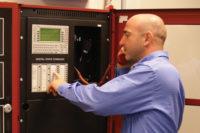

Dennis Raefield
SDM: You are very enthusiastic about hosted security applications based on a large centralized database that users connect to over a wide area connection. What are the benefits of this approach?
Raefield:It’s ideal for organizations with multiple locations, or where there is no security or information technology staff at a location, where there is a lot of turnover in management. Everything is programmed and managed remotely. There is no need to perform database backups and local system administration. There’s nothing that anyone has to do onsite. And people get the advantage of having an enterprise system without having to spend big money.
The central database can actually be more powerful than most enterprise systems. By using an Oracle or similar database, you can create “if/ then” scenarios and change them on the fly. An example would be an access control system that doesn’t just control entry to a building.
Instead, when a certain person comes in, it can unlock the door to that person’s office, turn on the lights in the hall between the door and that person’s office and so on. Even though that capability existed in the past, it always required horrendous programming skills to implement.
You can also do a lot of structured reports, save the template and ask Oracle to run the reports every Monday and deliver them by e-mail. If you have a local database, you can run the report, but you have to go to the system and do it.
SDM: I think there are also some applications that can be enabled using this type of centralized database that aren’t traditional security applications. Can you give some examples?
Raefield:One of the things that Edge Integration is doing is monitoring analog inputs. These are not “on” or “off” like a door switch. You can monitor a freezer, for example, and set it up so that if the temperature rises from 25 to 30 degrees, the system sends an e-mail to the manager. And if it continues, the next step might be to send a text message to the owner to say, “The temperature is still rising, and it hasn’t been resolved.”
SDM: What technology development enabled these distributed systems? Was it the move toward IP-based systems?
Raefield:That’s a large part of it because the system can share the wide area connection for the organization’s IT network. You’re using infrastructure that you’ve paid for already, rather than building a separate security infrastructure. But there’s more to it than that.
Many access control systems run on an IP network but only a secure centrally controlled corporate LAN. With the hosted approach that we’re talking about, you don’t have to be on a corporate network to make it work. Any connection to the Internet can work. You can create security immediately.
SDM: Is anyone using a hosted approach to integrate different types of security systems, such as access control and video?
Raefield:Manufacturers, including Edge Integration, are working on new capabilities in that area, but I can’t share details at this time. Edge Integration has already integrated access control with burglar alarms to the extent that one of the features of our panel is that it looks like a burglar alarm panel to the central station. The benefit of that approach is that the central station doesn’t have to invest any money in head-end software. We send alarms as the central station is used to seeing them. We work with any IP-based central station receiver.
SDM: Aren’t there security concerns when multiple customers are sharing their data in the same database?
Raefield:Security is very important. We think of it the way a bank does. You’re putting your money in the same bank as your neighbor’s money. But with good security, there’s no way to get to data that isn’t your own, just as there’s no way for your neighbor to get to your money in the bank.




![Screenshot_Security-Score_SC5.8-Dashboard_2736x1824_3x2[1] Screenshot_Security-Score_SC5.8-Dashboard_2736x1824_3x2[1]](https://www.sdmmag.com/ext/resources/Issues/2020/April/Screenshot_Security-Score_SC58-Dashboard_2736x1824_3x21.jpg?height=200&t=1586793661&width=200)